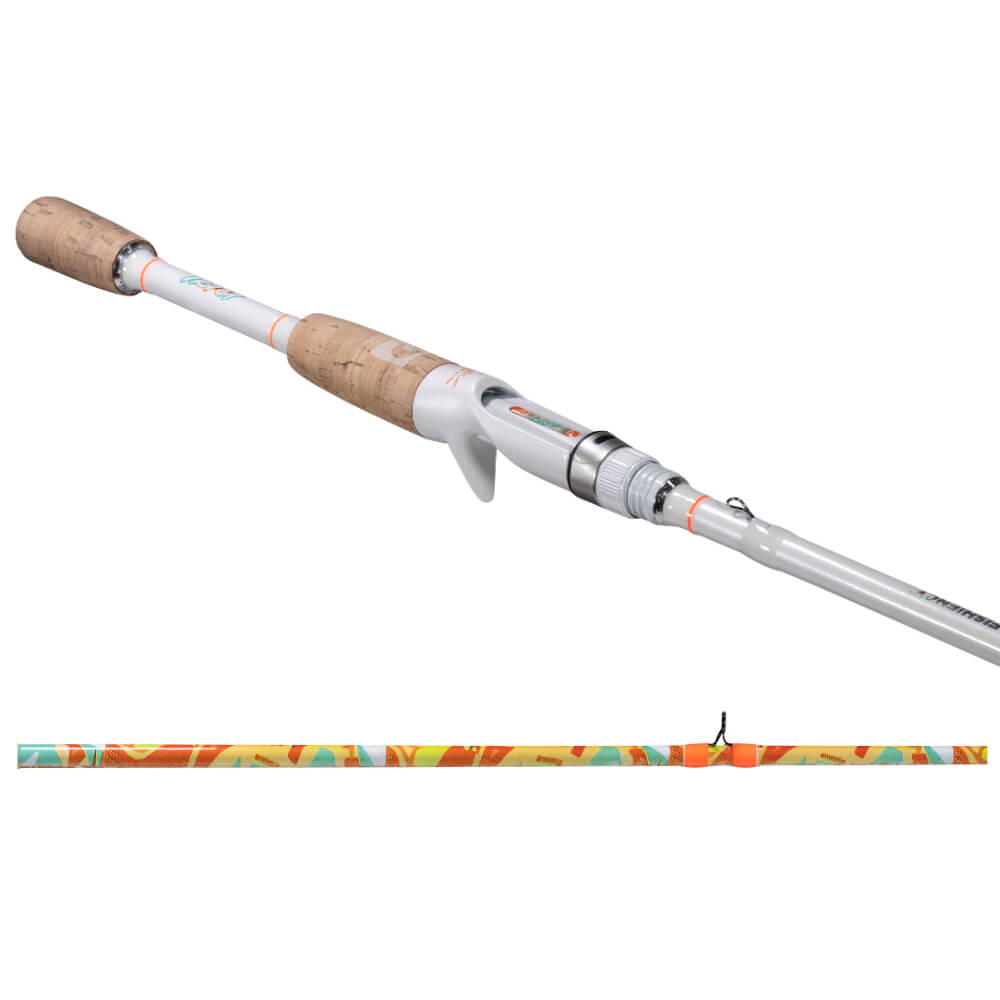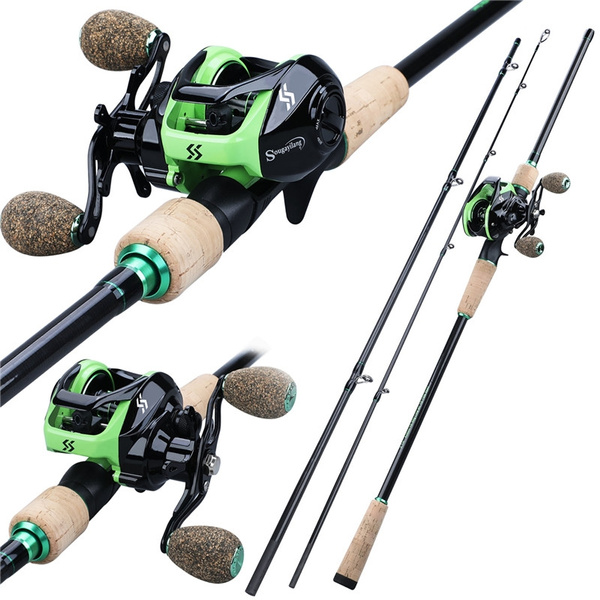The world of fishing gear is vast and varied. One tool stands out for its precision and power: the bait caster fishing rod. Whether you’re a seasoned angler or a novice, understanding the intricacies of this rod can elevate your fishing experience. In this article, we will delve into the nuances of bait caster fishing rods. We’ll explore their benefits, different types, and practical tips for choosing and using them effectively.
Understanding the Bait Caster Fishing Rod
What is a Bait Caster Fishing Rod?
A bait caster fishing rod is a specialized fishing rod. It is designed to give anglers more control and accuracy. Known for its strength and precision, it uses a bait casting reel. This reel is mounted on top of the rod. The reel design allows for longer casts and better control, especially with heavier lures. Anglers appreciate the bait caster for its versatility. It is capable of handling various fishing techniques, making it a favorite among serious fishermen. Transitioning from a spinning rod to a bait caster requires some adjustment. Many find the enhanced performance worth the learning curve.
Benefits of Using a Bait Caster
Bait caster fishing rods offer numerous advantages. Firstly, they provide greater casting distance. The design of the reel allows for a smoother line release. This results in longer and more accurate casts. Secondly, they offer increased control over the lure. Anglers can fine-tune their technique to achieve the desired presentation. Moreover, bait casters are robust. They can handle larger fish and heavier lines with ease. This makes them ideal for various fishing environments, from freshwater lakes to saltwater shores. Finally, they are durable. Built to withstand heavy use, they often outlast other types of fishing rods. This longevity makes them a wise investment for any angler.

Types of Bait Caster Fishing Rods
Freshwater Bait Caster Fishing Rods
Freshwater bait caster fishing rods are tailored for inland fishing. They are designed to cope with the challenges of freshwater environments. These rods are typically lighter and more sensitive. This allows anglers to detect subtle bites from smaller fish species. They are ideal for fishing in rivers, lakes, and reservoirs. More so, the sensitive tip helps in detecting finicky fish. Freshwater bait casters are perfect for bass fishing. Anglers often choose them for their precision and control. Additionally, these rods are compatible with a wide range of lures. This includes crankbaits, spinnerbaits, and soft plastics.
Saltwater Bait Caster Fishing Rods
Saltwater bait caster fishing rods are built to withstand harsh marine environments. They are constructed from corrosion-resistant materials. This ensures they can handle the rigors of saltwater. These rods are generally sturdier and heavier. They are designed to tackle larger and more powerful fish species. Anglers use them for deep-sea fishing, surf fishing, and pier fishing. Saltwater bait casters often feature reinforced guides and heavier line capacities. This is to accommodate the larger lures and stronger lines needed for ocean fishing. Furthermore, their robust design ensures they can handle the strain of battling large saltwater fish.
Travel Bait Caster Fishing Rods
Travel bait caster fishing rods are a convenient option for anglers on the go. These rods are designed to be compact and portable. They often come in multi-piece designs or telescopic models. This makes them easy to pack and carry. Travel bait casters do not compromise on performance. Despite their compact size, they offer the same strength and precision as standard models. They are suitable for both freshwater and saltwater fishing. These rods are ideal for anglers who travel frequently. Whether you’re heading to a remote fishing spot or a vacation, travel bait casters are a reliable option.
Choosing the Right Bait Caster Fishing Rod
Factors to Consider
When choosing a bait caster fishing rod, several factors come into play. Firstly, consider the rod’s power and action. Power refers to the rod’s strength, while action describes its flexibility. A rod with a fast action and heavy power is ideal for heavy lures and big fish. Conversely, a medium action rod with light power is suitable for smaller lures and fish. Additionally, consider the material. Graphite rods are lightweight and sensitive, while fiberglass rods are more durable.
Understanding Rod Specifications
Understanding rod specifications is crucial. Length, power, and action are key factors. Longer rods offer greater casting distance, while shorter rods provide better control. The rod’s power rating indicates its strength. Heavy power rods handle larger fish, while light power rods are better for smaller species. Action describes how much the rod bends. Fast action rods bend near the tip, medium action rods bend in the middle, and slow action rods bend near the handle. Each specification affects the rod’s performance and suitability for different fishing scenarios.
Matching the Rod to the Reel
Matching the rod to the reel is essential for optimal performance. Ensure the rod and reel are compatible in terms of power and action. A heavy power rod should be paired with a heavy-duty reel. Likewise, a light power rod should be matched with a lighter reel. The reel’s line capacity should also match the rod’s specifications. Additionally, consider the type of fishing you’ll be doing. For example, a saltwater rod should be paired with a saltwater reel. Properly matching the rod to the reel ensures a balanced setup. This enhances your fishing experience and increases your chances of success.

Tips for Using a Bait Caster Fishing Rod
Proper Casting Techniques
Mastering proper casting techniques is crucial. Start with a firm grip on the rod. Press the thumb bar to release the line. Use your thumb to control the spool. As you cast, apply pressure to the spool to prevent backlash. Practice smooth, controlled motions for accurate casts. Additionally, adjust the reel’s brake system to match the weight of your lure. This helps in achieving longer, more precise casts. Practicing in an open area can significantly improve your casting skills.
Maintenance and Care
Maintaining your bait caster fishing rod is essential for its longevity. After each use, particularly in saltwater, rinse the rod with fresh water. This prevents salt and debris buildup. Regularly check the guides for any signs of damage. Lubricate the reel regularly to ensure smooth operation. Store your rod in a cool, dry place. Use a rod sleeve to protect it from damage. Proper maintenance ensures your bait caster remains in good working condition for years.
Troubleshooting Common Issues
Despite their reliability, bait caster fishing rods can encounter issues. Backlash, where the line tangles, is common. To prevent this, adjust your reel’s brake system. Practice controlled casting techniques. Line spool knotting can occur if the line is not properly wound. Ensure even line distribution when spooling. Drag issues may arise, affecting line tension. Regularly check and adjust your reel’s drag settings. Most problems can be avoided with regular maintenance and practice.
Advantages and Disadvantages
Advantages
Bait caster fishing rods offer numerous advantages. They provide greater casting distance and accuracy. The reel design allows for a smooth line release. This leads to more precise casts. They offer increased control over the lure. This allows for more effective fishing techniques. Additionally, bait casters are incredibly robust. They can handle larger fish and heavier lines. This makes them suitable for various fishing environments. Their durability ensures they last longer. This makes them a wise investment for any serious angler.
Disadvantages
Despite their advantages, bait caster fishing rods have some drawbacks. They require a steep learning curve. Beginners may find them challenging to use initially. Backlash, or line tangling, is a common issue. It can be frustrating for novice anglers. Additionally, bait caster rods and reels are often more expensive. They require regular maintenance. This ensures they remain in good working condition. Despite these drawbacks, many anglers find the benefits outweigh the disadvantages. With practice and proper care, bait casters can enhance your fishing experience.

Conclusion
In conclusion, bait caster fishing rods are a valuable tool for any angler. Their precision, control, and durability make them a top choice for serious fishermen. Understanding the different types of bait casters helps in choosing the right one for your needs. Proper maintenance and casting techniques ensure optimal performance. While they may have a steep learning curve, the benefits of using a bait caster are undeniable. Investing in a quality bait caster fishing rod can significantly improve your fishing experience. Whether you’re fishing for freshwater bass or tackling large saltwater species, a bait caster rod is a reliable and powerful addition to your fishing gear.


















